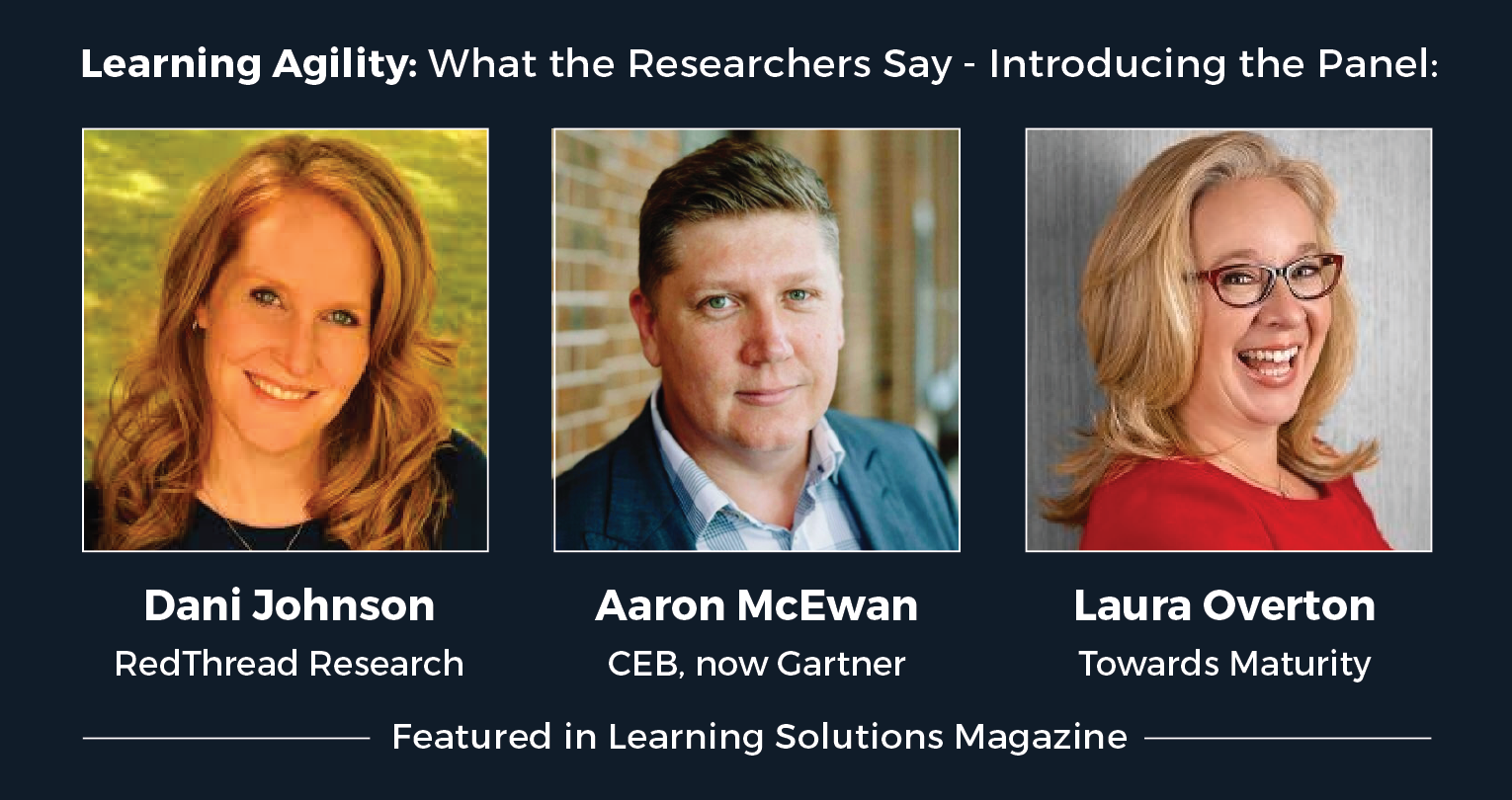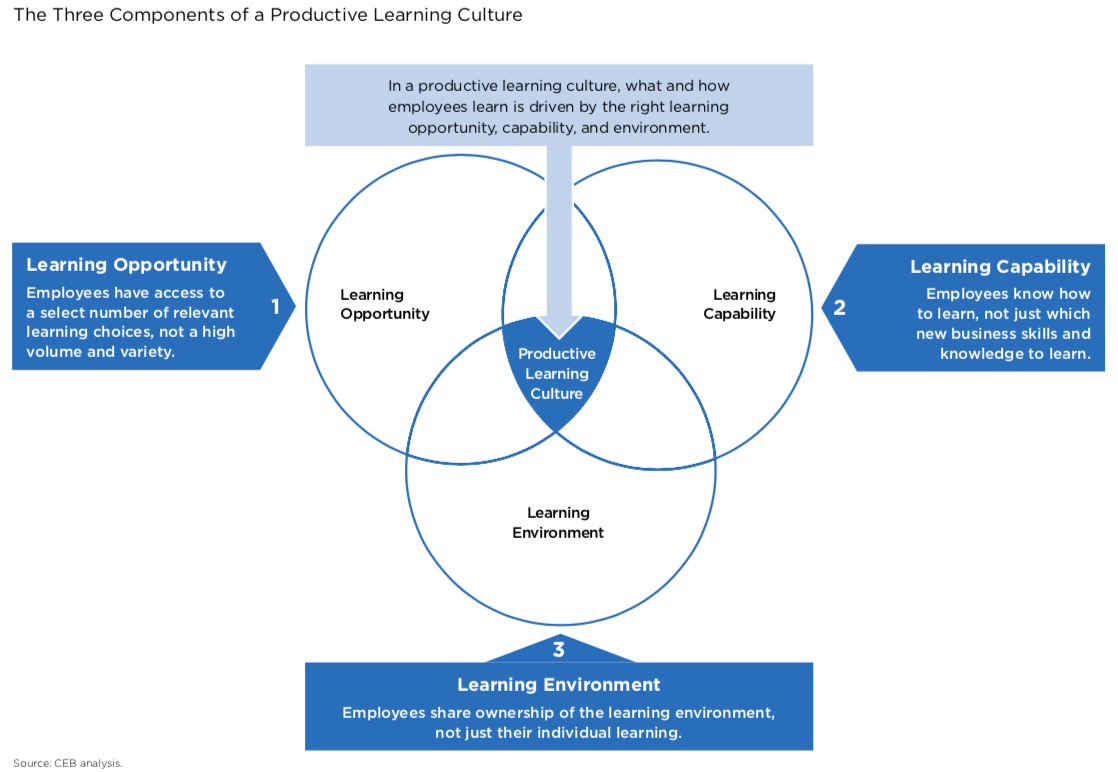Welcome to the third article in this series on learning agility. In this article, you will hear what a learning agility research panel said about the relevance and importance of learning agility to modern learning organizations: Dani Johnson of Red Thread Research, Aaron McEwan of CEB (now Gartner), and Laura Overton of Beyond Maturity. You may wish to review the initial articles of the series in order to refresh your memory of the earlier discussions (Learning Agility: Building Learning Organizations, and Learning Agility: Citi’s Campaign for Continuous Learning.)

Figure 1: The three panelists: Dani Johnson, Aaron McEwan, and Laura Overton
Learning agilitywho needs it?
The first question I posed to the panel was whether learning agility was broadly relevant to all sectors and industries, or to just a select few.
Dani Johnson, who recently left Bersin to co-found the new advisory firm RedThread Research, was clear. “I can’t think of an industry that isn’t being disrupted. And because of that, it’s impossible for workforces to assume their skills have a shelf life longer than five years—and much less in some cases.”
Aaron McEwan, from CEB, now Gartner, agreed. “Our research shows that the fastest growing demand for technology skills is actually across all jobs, not just technology-specific jobs.”
“As technology and automation advances, all employees will need to develop new skills and become increasingly comfortable with working alongside and, in many cases, working for intelligent machines. Traditional jobs requiring a narrow skillset will make way for less repetitive, non-routine work requiring complex problem-solving, curiosity, foresight, empathy, resilience, and accelerated learning.”
Laura Overton, from Towards Maturity, discussed how her organization’s research has identified a clear gap between aspiration and reality. “Speed and change are a priority across all sectors and learning leaders are recognizing that they should play a role in helping their organizations get there. The trouble is, less than one in four are achieving their goals.”
This is particularly alarming, since as Johnson reminded: “Organizations in all sectors that don’t find a way to develop learning agility will quickly be left behind.”
How are organizations achieving learning agility?
Fortunately, there are positive examples that we can learn from.
Overton cited the Towards Maturity Unlocking Potential report that includes a section on agility. “What stands out for organizations supporting agility is their use of social technologies that connect staff.”
Indeed, the report outlines that 57 percent of these “agility achievers” use learning communities such as action learning, and 77 percent use sharing applications. The report goes on to identify key tactics to cultivate agility including developing a strong customer profile; using content to connect and engage staff; stronger feedback related to business outcomes; and the importance of trial and error.
“More agile organizations,” continued Overton, “were twice as likely to encourage staff to learn from their mistakes and work closer to understand both ‘learner’ and business requirements.”
McEwan described three key areas to generate a productive learning culture revealed by his organization’s research: learning opportunity, learning environment, and learning capability. Each of these is explored in more detail in Figure 2 .

Figure 2: CEB, now Gartner, on the three components of a productive learning culture; used with permission
McEwan was particularly concerned about learning environment, noting that too much pressure is being placed on individuals to “go it alone.” He explained: “Real, transformational learning takes time and purposeful application, and organizations are still reluctant to provide employees with adequate time and headspace to learn.”
Johnson also looked to systematic and environmental issues in arguing the case to go beyond courses. “More evolved organizations tend to think more holistically,” Johnson said. “This means they simplify systems and processes, provide technology that establishes feedback loops to give information when needed, default to the work first for employee development, and establish an ongoing conversation about development to create the right type of consciousness.”
Readers may also want to watch the video of Nancy Giordano’s closing keynote at the Learning Solutions Conference & Expo 2018, Learning and the Future of Work. Nancy explores both the advancing technologies and the critical shifts that organizations (and the training departments that support them) must confront to stay relevant in the future.
Learning leaders
So what role must leaders play in the development of learning agility? A huge one apparently.
Johnson explained: “When an expectation for learning is set by leadership, the organization becomes much more agile—learning from mistakes, learning from each other, and making time and space for learning from mistakes as a part of the work.”
When asked what leaders should do to make this happen, Johnson replied simply. “Make it a priority. A good example of this is Satya Nadela at Microsoft [where] learning is a priority and we know that because everyone in the organization will tell you it is.”
Johnson also pointed to interesting initiatives to realign L&D within the business to embed this structurally. “A large financial firm recently moved their learning function from HR to Strategy. This sends a strong message to employees, but it also established learning as a priority, which changes how it is perceived, the time set aside for it, budget, and other key variables for success.”
McEwan agreed: “In successful companies, learning is taken seriously. It’s embedded in the culture, learners are taught how to learn and leaders are held accountable for supporting learning outcomes.
“For example, at American Express, all learning interventions include modules on how to extract what is relevant, reflect on what’s been taught, and apply those learnings on the job. At Hershey’s, leaders (and employees) have specific Key Performance Indicators that measure developing self, developing others, and enabling a learning environment.”
Overton discussed the need for learning and business leaders to share responsibility in supporting agility and developing a continuous learning culture.
Citing the Towards Maturity Transformation Curve report, Overton explained that of high-performing organizations, “Ninety-one percent agree that their organizations welcome innovation and contribution from workers, 85 percent create safe environments to work out loud, and 76 percent encourage staff to learn from mistakes. They’re also three times as likely to report business results linked to growth, profitability, productivity, and transformation—compelling evidence for leaders to consider doing something new!”
What can L&D do?
My final question explored opportunities for L&D to contribute to the development of learning agility.
“In a lot of cases,” Johnson said, “the best thing an L&D professional can do to enable people and organizations with learning agility is to get out of the way.”
“L&D professionals need to recognize that learning happens all over, all the time, that they don’t have control, and that their job is to enable it where it’s happening rather than controlling how it’s done.”
McEwan also took up the theme of enabling rather than delivering learning. “Learning professionals should spend less time teaching content and more time teaching learners how to learn, helping them identify and access the most relevant and critical learning interventions, and supporting them to share learnings across teams and the broader network.
“My colleague, Robin Boomer, has been exploring the idea that learning professionals should operate more like learning ‘concierges’ who recommend, guide, and provide advice to maximize learning.”
Overton noted that even the most passionate L&D professionals who are aware of the required change will often “struggle to get buy-in for new ideas, especially when they are challenging the status quo.”
Her advice to help create buy-in necessary for change?
“It’s time to make more use of the independent evidence around to help plan and persuade and improve performance,” Overton argued. “Conversations are the pathway to lasting change and data opens conversations in a way that opinions on new ideas rarely do.”
I’d have to agree.
Hopefully this article provides a glimpse into the invaluable contribution Johnson, McEwan, and Overton—and the research organizations they represent—are making to support the case for change.
We’re fortunate to have people like these in our corner, and I encourage you to use their services to build an evidence-based approach to developing learning agility.
Next time—the “F” word!
The next learning agility column will be about the “F” word.
Yes, we’ll be talking about failure and (spoiler alert) I’ll be exploring the following diagram, which is a slightly adapted model from one first described by Julie Birkinshaw and Martine Haas (Figure 3).

Figure 3: Return on Failure formula developed by Birkinshaw and Haas, used with permission
For now, this is a call out for your input. Do you have an example of how your organization decreased resources spent on failure (e.g. by prototyping), or increased actionable insights (e.g. through root-cause analysis of failure)?
Alternatively, have you helped shift culture to improve psychological safety and reframe failure?
Please contact me via LinkedIn or Twitter to tell me about your experiences and perhaps have your story profiled in the next Learning Agility column.



